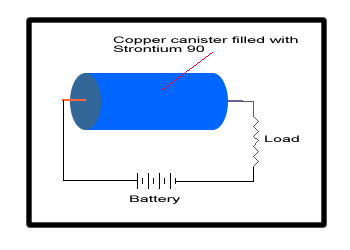|
Nuclear
Batteries
Since
the 1950s, numerous designs have been developed for
Nuclear Batteries as a long lived, compact, portable
source of electrical power.
Nuclear
Thermal Battery
In the Nuclear Thermal Battery, the heat generated by
radioactive decay of a radioactive substance is converted
into electricity by a thermoelectric generator (e.g.
a Peltier element). This uses the Peltier/Seebeck Effect
to convert a temperature gradient directly into electricity.
This technology is used on space probes but its efficiency
is low.
Betavoltaic
Battery
In the Betavoltaic battery, which has been known for
over 50 years, a semiconductor PN junction is exposed
to beta particles (electrons) emitted by a radioactive
substance. This in turn then generates electricity.
In
May 2005, the University of Rochester announced the
development of a 3D Silicon Diode fabricated in porous
silicon. This greatly increases the PN junction surface
area exposed to beta radiation from a tritium radioactive
source. The tritium is incorporated into a plastic to
prevent its accidental loss. The technology has been
licensed to BetaBatt
Inc, who call it the Direct Energy Conversion Cell
or DEC Cell.
Betabatt
state that the power developed by this technology is
between 50 and 125 microWatts per cc of active material.
It is therefore a very low power source, suitable for
long life applications where battery replacement is
difficult or inconvenient.
For
an example of an earlier version of this technology,
see US Patent 3,094,634 issued in 1963. This used a
PN junction formed by Silicon doped with Boron on one
side and Silicon doped with Antimony on the other.
Resonant
Nuclear Battery
Not only PN junctions but any dipole or potential barrier
- such as the electric field between the plates of a
capacitor, a metal-semiconductor junction, a metal to
dissimilar metal contact potential - exposed to radiation
will give rise to an electric current flow. Radiation
that is absorbed in the vicinity of any potential barrier
will generate separated electron-hole pairs which in
turn flow as electric current under the influence of
the electric potential field.
In
the 1980s, researcher Dr Paul Brown used the Betavoltaic
effect to develop what he called the Resonant Nuclear
Battery. The beta particles from a radioactive source
(Sr90 or Kr85) are absorbed by a Beryllium-Copper resistor
linked to an LC tank circuit with a coil made of Silver.
Each beta particle absorbed by a copper wire releases
80,000 free electrons within a distance of 0.762mm.
With a potential applied to the wire, these free electrons
will flow, creating a current.
 An
earlier version of this concept was patented in 1970
by Burke (US 3,530,316). The basic principle is shown
on the right. An
earlier version of this concept was patented in 1970
by Burke (US 3,530,316). The basic principle is shown
on the right.
A
copper canister was filled with Strontium 90 and connected
in series with a battery and load. The free electrons
generated in the copper canister by the radioactive
decay of the Sr90 then amplify the current supplied
by the battery and power the load.
It
can be seen that a High Impedance Battery (a battery
with a high internal resistance) that supplies voltage
but little current would be ideally suited for this
system. The battery supplies very little current and
so will have a very long life; current is supplied instead
by the radioactive source. This combines with the voltage
source (the battery) to provide a Combined High Power
Source of long life.
Paul
Brown's Resonant Nuclear Power Supply is effectively
an LC tank circuit oscillating at its self resonant
frequency driven by radioactive decay energy.
A
small prototype the size of a soup can produced a continuous
75W.
This
technology used waste Strontium 90 or Krypton 85 from
spent nuclear fuel rods.
References
1.
"Resonant Nuclear Battery May Aid in Mitigating
the Greenhouse Effect", PM Brown, Trans. Am.
Nucl. Soc., 60, 491, (1989).
2."Electric
Power Methods and Apparatus", JO Burke, US 3,530,316
Battery Motors
Atmospheric Remediation
|
